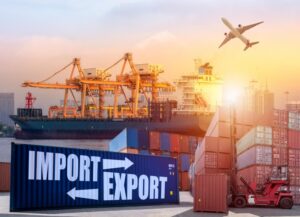Trade deficit’s $3.5bn six-year high ‘tremendous opportunity’
14 Feb 2024
 The Bahamas National Statistical Institute recently released trade statistics
The Bahamas National Statistical Institute recently released trade statistics
The Bahamas faces “a tremendous opportunity” if it can start making inroads into a trade deficit that hit a six-year high of around $3.487bn in 2023, it was argued yesterday.
Philip Galanis, the Bahamas Trade Commission’s chairman, conceded to Tribune Business that merely starting to narrow the vast multi-billion gap between this nation’s goods exports and its huge import bill is “probably as much as we can all hope for in the short-term”.
Speaking as the Bahamas National Statistical Institute released the 2023 fourth quarter and full-year trade statistics, which showed that the deficit had increased by around 7 percent or $233m year-over-year compared to 2022, he nevertheless said the Commission is working on multiple initiatives aimed at bridging the growing divide.
Besides identifying Bahamian companies and products that are export-ready, and helping them to penetrate new overseas markets, Mr Galanis told this newspaper that the Commission is also seeking out new import sources in a bid to obtain lower prices and ease both inflation and the post-COVID cost of living crisis.
The Bahamas Trade Commission is hosting a trade mission to Brazil
Revealing that the Government body is planning to host a trade mission to Brazil during the 2024 first quarter, he added that The Bahamas is also “increasing dialogue and engagement with China” to see if transportation costs and, as a result, local consumer prices can be lowered via direct shipping as opposed to transiting through the US and other nations.
Mr Galanis also voiced optimism that the planned wholesale reform of The Bahamas’ intellectual property rights (IP) protection regime will help stimulate exports by local artists and creative industries in the so-called ‘orange economy’, adding that several African nations have expressed interest in local art.
Ultimately, if The Bahamas achieves its twin National Trade Policy objectives of boosting physical goods exports and slashing imports, it will reduce the amount of tour- ism and financial services foreign currency earnings that have “to do an almost immediate about face” and exit this nation to finance its massive import bill.
Asserting that cutting imports will “strengthen the economy” and bolster both the foreign currency reserves and one:one exchange rate peg with the US dollar, Mr Galanis acknowledged that “it’s going to be a long, long time before” the trade deficit – which measures by how much The Bahamas’ physical goods’ imports exceed its exports – is cut by any great extent.
The data released by the Bahamas National Statistical Institute revealed that the trade deficit for the 2023 fourth quarter, while shrinking slightly by almost $16m year-over-year, still stood at $902.673m as opposed to $918.448 for the final three months of 2022.
The moderately improved outcome stemmed from a $28m drop in total imports, which fell from $1.074bn in the 2022 fourth quarter to $1.045bn last year. The outcome may have been helped by moderating global inflation and a reduction in oil prices, as The Bahamas’ oil imports fell by more than $56m or nearly 30 percent year-over-year, declining from $189.811m to $133.667m in the 2023 fourth quarter.
Bahamian exports for the same period, meanwhile, declined by just under $12.5m to $142.719m for the three months to end- December 2023. The data showed that physical goods exported, or re-exported, from The Bahamas totalled just over $600m for the 2023 full-year – a figure that was dwarfed almost seven times’ by some $4.187bn worth of exports.
The Bahamas’ quarterly trade deficits added up to $3.487bn for the full year. This figure is hardly surprising given that this nation imports virtually all it consumes, but the $233m increase upon 2022’s $3.254bn deficit – itself a five-year high – indicates the growing strain being placed on The Bahamas’ foreign exchange earning sectors.
That $3.487bn represents foreign exchange that The Bahamas has to generate through a surplus on its capital account, representing monies earned by services exporters such as tourism and financial services, to cover the trade deficit and fund essential imports. Between 2018 and 2022, the trade deficit peaked at just shy of $3bn in 2018, with imports reaching a pre-2023 high of $3.524bn that year.
Plans to diversify this nation’s import source markets
With the identification of “import substitution”, meaning goods that can be manufactured in The Bahamas to replace foreign products, representing a starting point, Mr Galanis yesterday said the body is also exploring diversifying this nation’s import source markets in a bid to further ease inflation.
“We are looking at the Trade Commission where we are importing our goods from,” the Trade Commission chair said, adding that The Bahamas would automatically benefit by sourcing from nations with relatively lower inflation. “The extent to which we’re able to reduce inflation will be a benefit for consumers because, all things being equal and assuming retail- ers pass those savings in, it will bring prices down.
“Many of the imports we bring in from the US are not necessarily from or made in the US. They are imported through the US and classified as US imports. One of the things the Trade Commission has been focused on is looking at where other countries might offer us benefits.
“We’re planning a trade mission to Brazil in the first quarter of this year. We’re increasing our dialogue and engagement with China because a lot of goods from China come [through other nations], and if we can reduce the economics of transportation costs we will begin to see some benefits.”
Besides lower-cost imports, Mr Galanis added: “We’re trying to encourage exports, identifying goods and services – primarily goods – that are ready for export, and getting them into foreign markets that they may have some difficulty penetrating.”
Apart from reviewing The Bahamas’ existing trade agreements with the likes of the US, Canada, UK and European Union (EU), he said: “There are other countries that have expressed interest. A number of countries in Africa have expressed interest in importing Baha-mian goods like artwork, and the Caribbean.
“For too long we have not really looked sufficiently closely at our neighbours to the south. We have increasingly brought goods in from our neighbours from the south, but have not really exported to them. I think we need to find out if there are ways we can do so.
“We’ve been working very closely with the Small Business Development Centre to determine which products they are promoting which are export-ready, and to assist those business owners with access to foreign markets. Often-times the benefits are available but what is lacking is the know-how and how to penetrate foreign markets.”
Mr Galanis also voiced hope that the upcoming reforms to The Bahamas’ IP regime will encourage local artists and artisans to export more of their creative works with “less fear of having them expropriated” by other persons.
Pointing to the benefits of reducing the import bill’s drain on The Bahamas’ foreign currency reserves, the Trade Commission chair added: “We build our reserves if we’re able to reduce our imports, and the reserves begin to grow and that strengthens the economy. More dollars stay in the system to be used by the Government or for private consumption.
“A lot of the money that comes into the country has to do an about face almost immediately to pay for the goods we import. The benefit of reducing the trade deficit is one:one by having these dollars stay in the country. That’s a positive for us.
“We are talking more about the trade deficit that we ever did before. There’s a lot going on in trade, a tremendous amount going on in trade. We’ve been talking more about trade in the last six months than we have in the last six years.”
Source: Tribune

